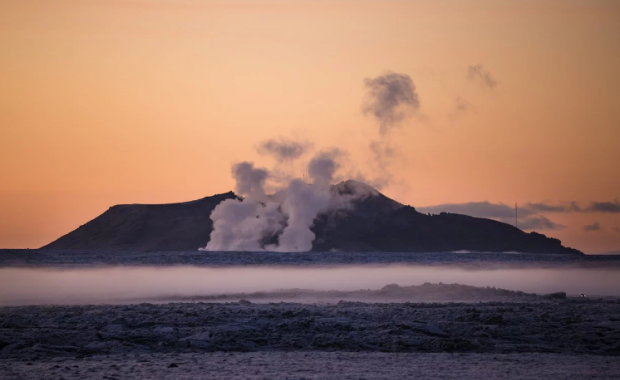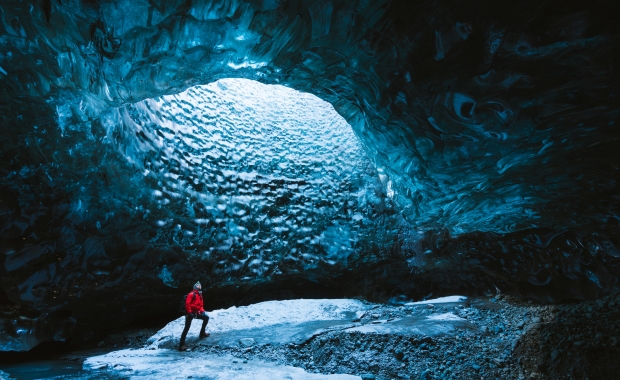A local man who was walking his dog near the village of Hafnir on Monday was stunned to discover the dog had discovered a Raccoon. Raccoons are not native to Iceland and have never lived wild in the island. In the mid-20th century raccoons were farmed for their for fur on a very small scale, but no raccoons have been have seen in Iceland for at least 20 years.
Raccoon burrow discovered by dog
Birgir Hauksson who lives in Hafnir, one of the small fishing villages on Reykjanes peninsula, near the Keflavík International Airport, told the National Broadcasting Service RÚV that he was walking his dog on the beach searching for shells when he heard the dog had discovered something more interesting in a hole next to the beach:
We were searching for shells, but the dog isn't very interested in shells so he was just running around doing whatever he likes to do. I thought he had found a mink, like he does sometimes, but the sounds coming from the burrow, and I went to check it out.
Birgir told RÚV that his dog was clearly in some sort a confrontation with a smaller animal. Based on the sounds it sounded the animal might be a crazed feral cat. When he came closer he discovered it was a raccoon. Birgir, who is a hunter, quickly killed the raccoon and delivered the carcass to the University of Iceland where it will be studied and tested for animal diseases.
Nothing is know about the origins of the raccoon, according to a statement from the Food and Veterinary Authority. The animal must either have come to Iceland as a stowaway on a ship, or he was smuggled into the island by someone. The importation of live raccoons and other wild animals to Iceland is illegal.
Raccoons not native to Iceland
Due to the remoteness and inhospitable climate of Iceland only a handful of land animals have been able to make Iceland its home. The only land mammal which is native to Iceland is the Arctic Fox: All other land mammals have been brought to the island by people. And the authorities keep a very close watch on all animals who enter the country to ensure no new animal diseases or unwanted invasive species are introduced into the country.
Read more: Cat smuggled to Iceland in RV by Swiss traveller not the first travelling pet put down by police
The authorities are particularly careful to monitor any incoming animals for rabies. Raccoons are known carriers of rabies.
Raccoons were raised on small scale for their fur between 1930 and 1950. After the fur farming had been abandoned no raccoons were brought to Iceland until 1976 when three raccoons were imported by a local zoo. One of these animals escaped but was caught and killed in the harbor area in Hafnarfjörður, a suburb of Reykjavík.
The only other raccoon sighting in Iceland was in the late 90s when a raccoon was discovered on the harbor in Reykjavík. This animal had arrived in Iceland on a container ship.
A local man who was walking his dog near the village of Hafnir on Monday was stunned to discover the dog had discovered a Raccoon. Raccoons are not native to Iceland and have never lived wild in the island. In the mid-20th century raccoons were farmed for their for fur on a very small scale, but no raccoons have been have seen in Iceland for at least 20 years.
Raccoon burrow discovered by dog
Birgir Hauksson who lives in Hafnir, one of the small fishing villages on Reykjanes peninsula, near the Keflavík International Airport, told the National Broadcasting Service RÚV that he was walking his dog on the beach searching for shells when he heard the dog had discovered something more interesting in a hole next to the beach:
We were searching for shells, but the dog isn't very interested in shells so he was just running around doing whatever he likes to do. I thought he had found a mink, like he does sometimes, but the sounds coming from the burrow, and I went to check it out.
Birgir told RÚV that his dog was clearly in some sort a confrontation with a smaller animal. Based on the sounds it sounded the animal might be a crazed feral cat. When he came closer he discovered it was a raccoon. Birgir, who is a hunter, quickly killed the raccoon and delivered the carcass to the University of Iceland where it will be studied and tested for animal diseases.
Nothing is know about the origins of the raccoon, according to a statement from the Food and Veterinary Authority. The animal must either have come to Iceland as a stowaway on a ship, or he was smuggled into the island by someone. The importation of live raccoons and other wild animals to Iceland is illegal.
Raccoons not native to Iceland
Due to the remoteness and inhospitable climate of Iceland only a handful of land animals have been able to make Iceland its home. The only land mammal which is native to Iceland is the Arctic Fox: All other land mammals have been brought to the island by people. And the authorities keep a very close watch on all animals who enter the country to ensure no new animal diseases or unwanted invasive species are introduced into the country.
Read more: Cat smuggled to Iceland in RV by Swiss traveller not the first travelling pet put down by police
The authorities are particularly careful to monitor any incoming animals for rabies. Raccoons are known carriers of rabies.
Raccoons were raised on small scale for their fur between 1930 and 1950. After the fur farming had been abandoned no raccoons were brought to Iceland until 1976 when three raccoons were imported by a local zoo. One of these animals escaped but was caught and killed in the harbor area in Hafnarfjörður, a suburb of Reykjavík.
The only other raccoon sighting in Iceland was in the late 90s when a raccoon was discovered on the harbor in Reykjavík. This animal had arrived in Iceland on a container ship.







